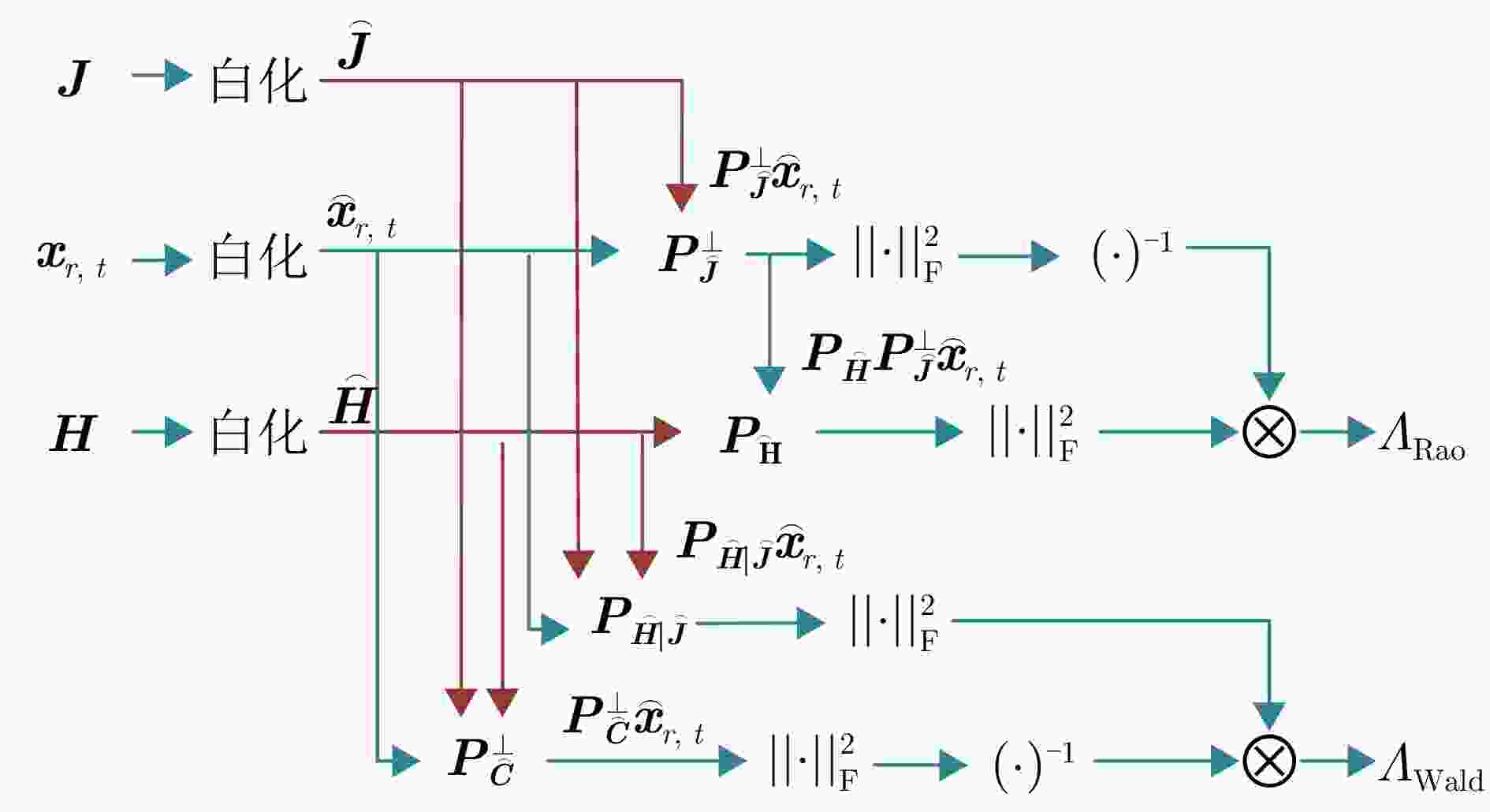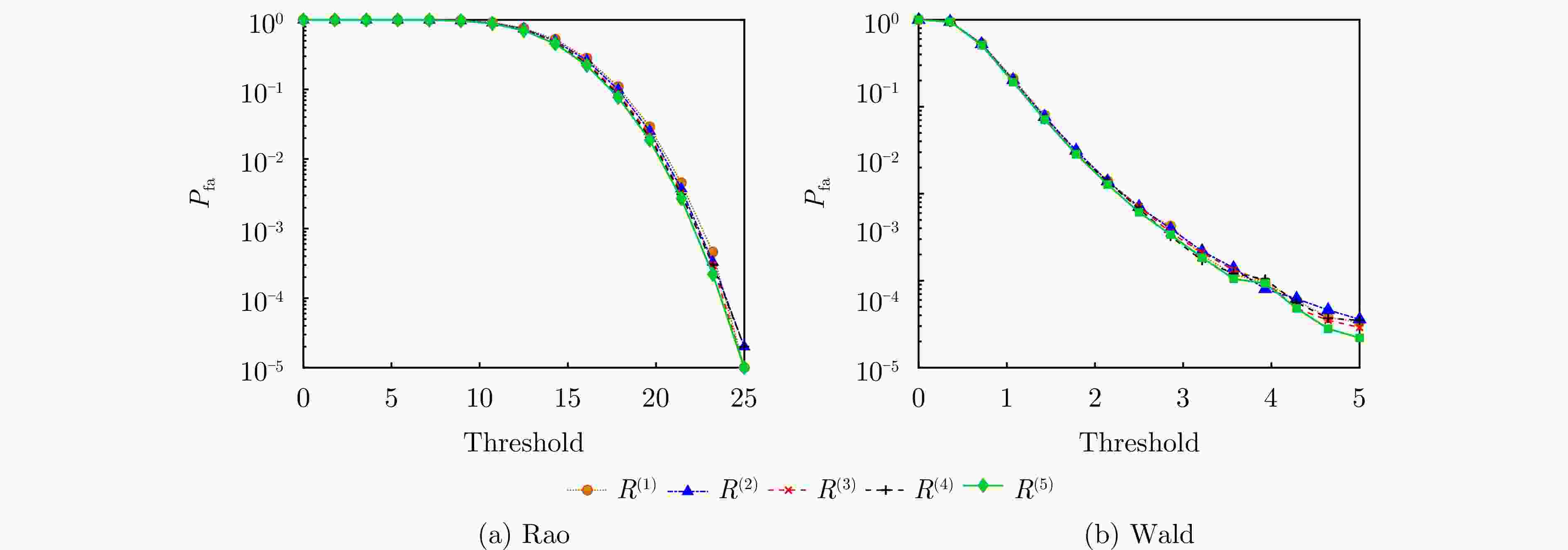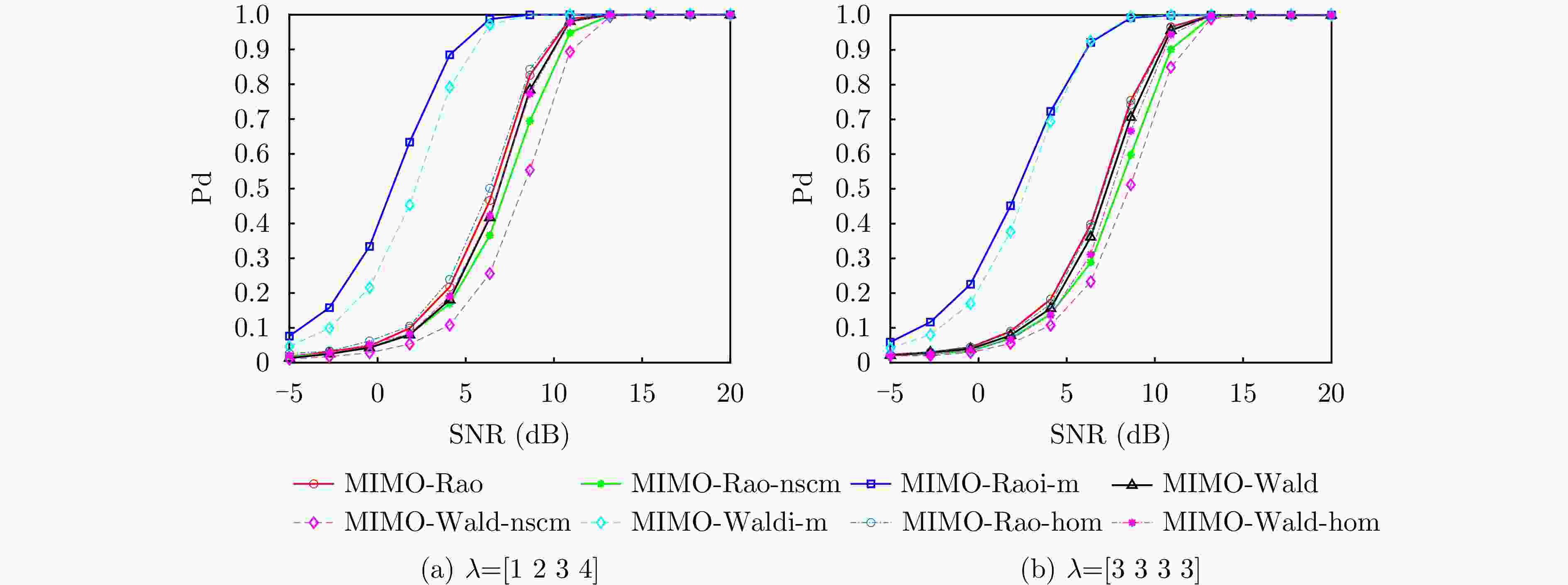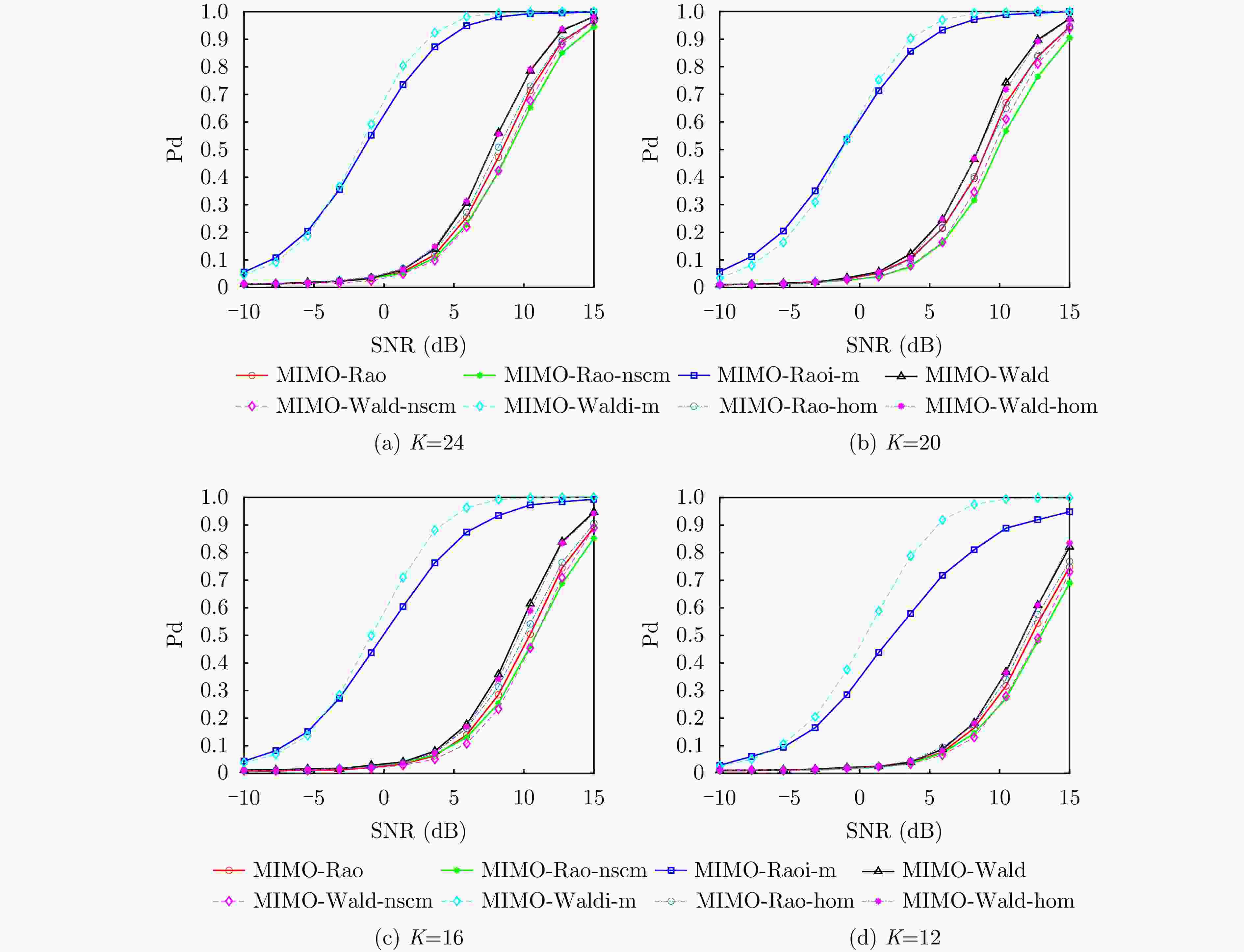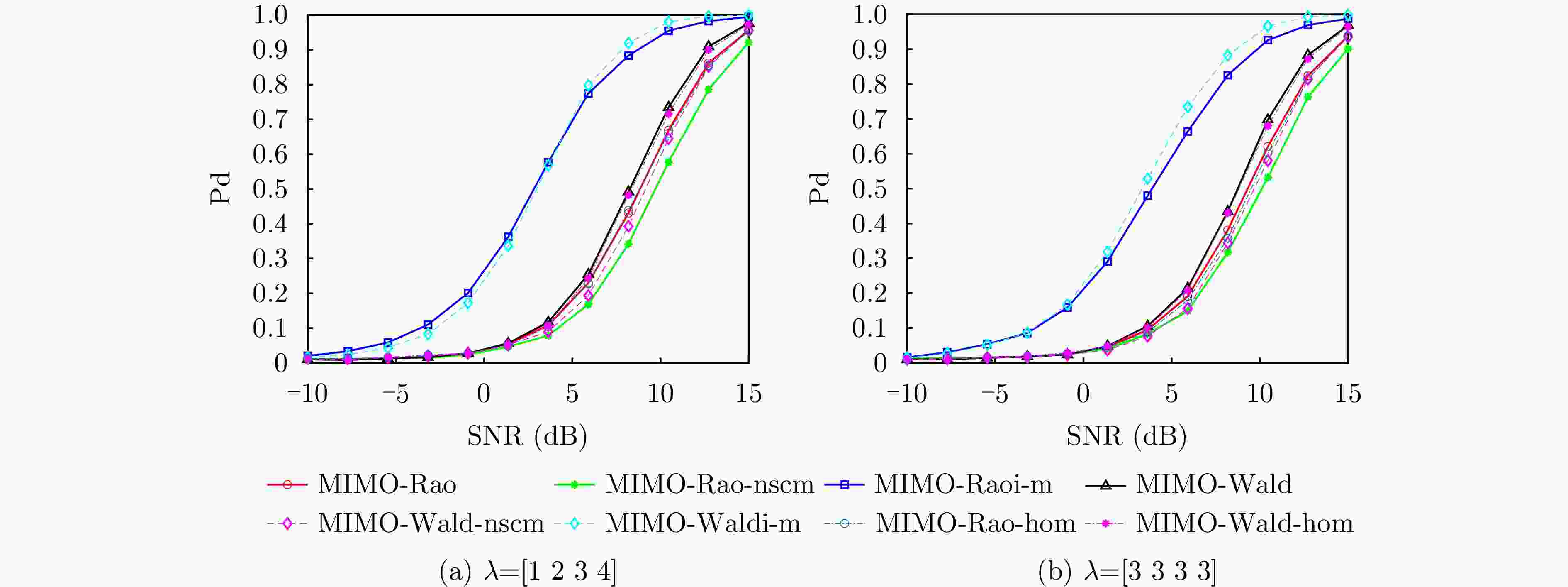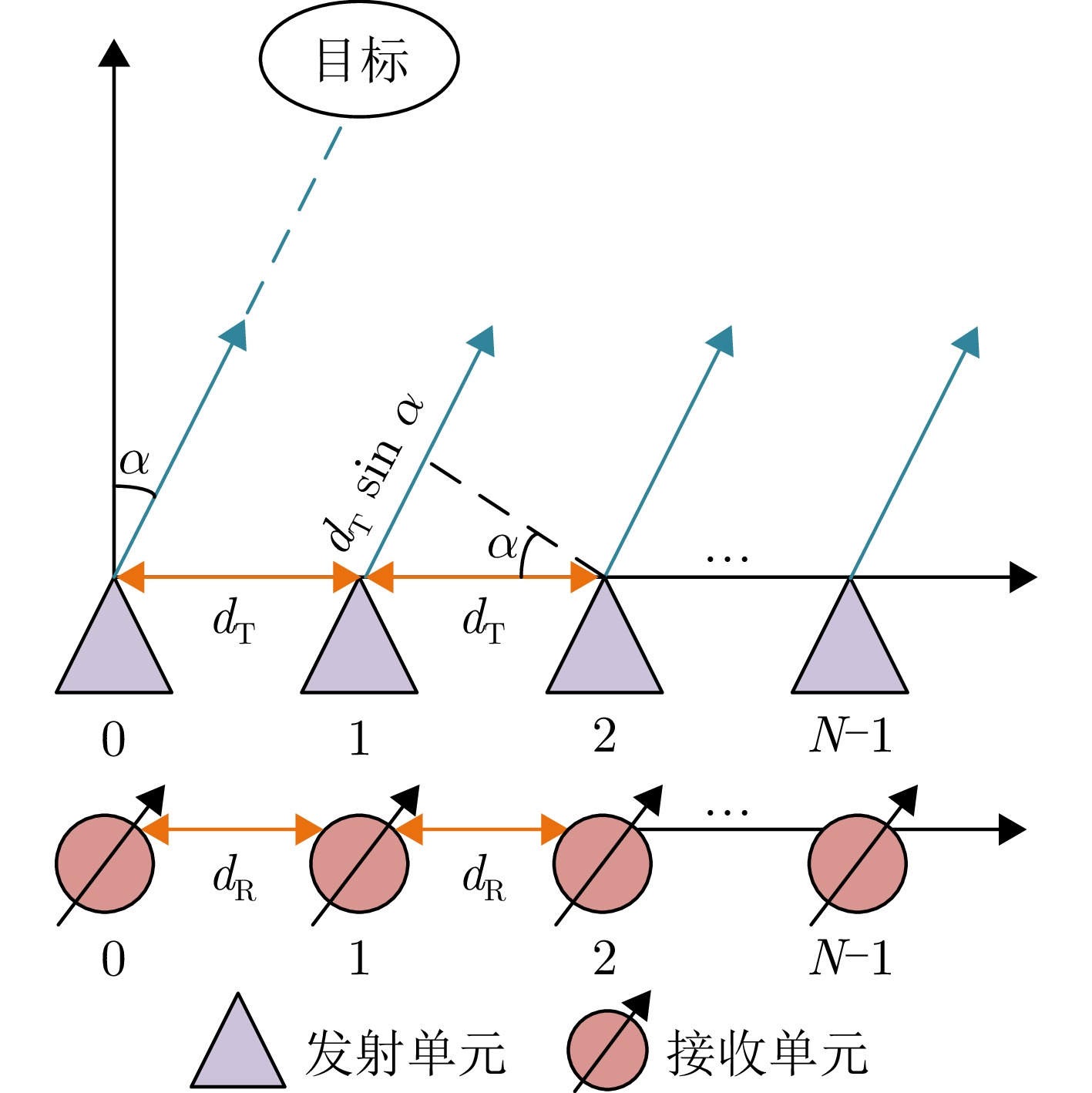Double Hierarchical Nonhomogeneous Multirank Target Detection Method for Distributed MIMO Radars in Subspace Interference Scenarios
-
摘要: 针对分布式多输入多输出(MIMO)雷达在子空间干扰和非均匀杂波中检测目标场景,该文提出了一种面向分布式MIMO雷达双层非均匀多秩目标检测方法。首先,利用目标信号和干扰位于两个相互线性独立且秩大于 1 的子空间,两个子空间对应的子空间矩阵和相应距离单元的坐标向量都是未知的,建立了多秩目标模型及子空间干扰模型;然后,设计分布式MIMO雷达系统的双层非均匀结构,每个发射-接收对的干扰是非均匀的,即每个发射-接收对具备不同的统计量。此外,每一个发射接收对的杂波是非均匀的。在此基础上,通过采取Rao与Wald检验准则,构建待解参数估计策略,并通过功率中值归一化协方差估计,设计了面向分布式MIMO雷达子空间干扰背景下双层非均匀多秩目标Rao检测器和Wald检测器。最后,通过理论推导证明了所提检测方法相对于杂波协方差矩阵结构具有恒虚警特性。仿真实验结果表明,所提检测方法能够保证对杂波协方差矩阵结构具有恒虚警特性,此外,相较于现有分布式MIMO雷达检测方法,所提检测方法有效改善了目标检测性能和干扰抑制性能。Abstract: The paper proposes a double hierarchical nonhomogeneous multirank target detection method for the distributed Multiple-Input Multiple-Output (MIMO) radar to detect targets in scenarios with subspace interference and nonhomogeneous clutter. First, a multirank target model and subspace interference model are established based on the fact that the target signal and interference are located in two linearly independent subspaces, each with a rank greater than 1. The corresponding subspace matrices of the two subspaces and the coordinate vectors of the corresponding distance units are unknown. Then, a distributed MIMO radar system with a double hierarchical nonhomogeneous structure is designed, and the interference of each transmit-receive pair is nonhomogeneous, i.e., each transmit-receive pair possesses different statistics. In addition, the clutter in one transmit-receive pair is nonhomogeneous. Subsequently, the double hierarchical nonhomogeneous multirank target Rao detector and Wald detector are designed for the distributed MIMO radar in the context of subspace interference. This is achieved by adopting the Rao and Wald test criteria, constructing the parameter estimation strategy to be solved, and estimating the power median normalized covariance. Theoretical derivation showed that the proposed method had a constant false alarm property for the clutter covariance matrix structure. Simulation experiments showed that the proposed method guarantees a constant false alarm property for the clutter covariance matrix structure; in addition, compared with the existing distributed MIMO radar detection methods, the proposed detection method improves the target detection and interference suppression performances.
-
表 1 所有检测器的计算复杂度
Table 1. Computational complexity of all detectors
检测器名称 计算复杂度 MIMO-Rao-hom与
MIMO-Wald-hom$O(MN{L^3})$ MIMO-Rao与MIMO-Wald $ O(MN({L^3} + {L^2}K)) $ MIMO-Rao-nscm与
MIMO-Wald-nscm$O(MN({L^3} + {L^2}K + LK))$ MIMO-Raoi-m与MIMO-Waldi-m $O(MN ({L^3} + {L^2}K + K\log_2 K))$ -
[1] 王永良, 刘维建, 谢文冲, 等. 机载雷达空时自适应检测方法研究进展[J]. 雷达学报, 2014, 3(2): 201–207. doi: 10.3724/SP.J.1300.2014.13081.WANG Yongliang, LIU Weijian, XIE Wenchong, et al. Research progress of space-time adaptive detection for airborne radar[J]. Journal of Radars, 2014, 3(2): 201–207. doi: 10.3724/SP.J.1300.2014.13081. [2] 韩金旺, 张子敬, 刘军, 等. 基于贝叶斯的高斯杂波背景下MIMO雷达自适应检测算法[J]. 雷达学报, 2019, 8(4): 501–509. doi: 10.12000/JR18090.HAN Jinwang, ZHANG Zijing, LIU Jun, et al. Adaptive Bayesian detection for MIMO radar in Gaussian clutter[J]. Journal of Radars, 2019, 8(4): 501–509. doi: 10.12000/JR18090. [3] HAIMOVICH A M, BLUM R S, and CIMINI L J. MIMO radar with widely separated antennas[J]. IEEE Signal Processing Magazine, 2008, 25(1): 116–129. doi: 10.1109/MSP.2008.4408448. [4] LIU Jun, ZHANG Zijing, GAO Yunhe, et al. A closed-form expression for false alarm rate of adaptive MIMO-GLRT detector with distributed MIMO radar[J]. Signal Processing, 2013, 93(9): 2771–2776. doi: 10.1016/j.sigpro.2013.03.001. [5] GAO Yongchan, LI Hongbin, and HIMED B. Knowledge-aided range-spread target detection for distributed MIMO radar in nonhomogeneous environments[J]. IEEE Transactions on Signal Processing, 2017, 65(3): 617–627. doi: 10.1109/TSP.2016.2625266. [6] MAO Linlin, LI Hongbin, and ZHANG Qunfei. Transmit subaperturing for MIMO radars with nested arrays[J]. Signal Processing, 2017, 134: 244–248. doi: 10.1016/j.sigpro.2016.12.016. [7] LIU Weijian, LIU Jun, HAO Chengpeng, et al. Multichannel adaptive signal detection: Basic theory and literature review[J]. Science China Information Sciences, 2022, 65(2): 121301. doi: 10.1007/s11432-020-3211-8. [8] HE Qian, LEHMANN N H, BLUM R S, et al. MIMO radar moving target detection in homogeneous clutter[J]. IEEE Transactions on Aerospace and Electronic Systems, 2010, 46(3): 1290–1301. doi: 10.1109/TAES.2010.5545189. [9] HE Qian and BLUM R S. Diversity gain for MIMO Neyman-Pearson signal detection[J]. IEEE Transactions on Signal Processing, 2011, 59(3): 869–881. doi: 10.1109/TSP.2010.2094611. [10] DE MAIO A, LOPS M, and VENTURINO L. Diversity-integration tradeoffs in MIMO detection[J]. IEEE Transactions on Signal Processing, 2008, 56(10): 5051–5061. doi: 10.1109/TSP.2008.928693. [11] TANG Jun, LI Ning, WU Yong, et al. On detection performance of MIMO radar: A relative entropy-based study[J]. IEEE Signal Processing Letters, 2009, 16(3): 184–187. doi: 10.1109/LSP.2008.2011704. [12] 高永婵, 潘丽燕, 李亚超, 等. 空/时对称阵列雷达非高斯杂波背景下多秩距离扩展目标检测方法[J]. 雷达学报, 2022, 11(5): 765–777. doi: 10.12000/JR22013.GAO Yongchan, PAN Liyan, LI Yachao, et al. Multi-rank range-spread target detection method for space/time symmetric array radar under non-Gaussian clutter background[J]. Journal of Radars, 2022, 11(5): 765–777. doi: 10.12000/JR22013. [13] ZENG Cengcang, WANG Fangzhou, LI Hongbin, et al. Bayesian detection for distributed MIMO radar with non-orthogonal waveforms in non-homogeneous clutter[C]. 2023 IEEE Radar Conference, San Antonio, USA, 2023: 1–6. doi: 10.1109/RadarConf2351548.2023.10149555. [14] 兰云, 唐亮, 卜智勇, 等. 非均匀杂波背景下MIMO雷达扩展目标自适应检测器[J]. 中国科学院大学学报, 2021, 38(4): 524–531. doi: 10.7523/j.issn.2095-6134.2021.04.012.LAN Yun, TANG Liang, BU Zhiyong, et al. Range spread target adaptive detector for distributed MIMO radar in nonhomogeneous environment[J]. Journal of University of Chinese Academy of Sciences, 2021, 38(4): 524–531. doi: 10.7523/j.issn.2095-6134.2021.04.012. [15] HASSANIEN A, HIMED B, and RIGLING B D. Moving target detection using fast iterative interpolated beamforming for distributed MIMO radar in non-homogeneous clutter[C]. 2019 53rd Asilomar Conference on Signals, Systems, and Computers, Pacific Grove, USA, 2019: 624–629. doi: 10.1109/IEEECONF44664.2019.9048827. [16] SMITH J P and SHAW A. Moving target detection using distributed MIMO radar in non-homogeneous clutter with limited training data[C]. 2020 54th Asilomar Conference on Signals, Systems, and Computers, Pacific Grove, USA, 2020: 617–622. doi: 10.1109/IEEECONF51394.2020.9443323. [17] GINOLHAC G, FORSTER P, OVARLEZ J P, et al. Spatio-temporal adaptive detector in non-homogeneous and low-rank clutter[C]. 2009 IEEE International Conference on Acoustics, Speech and Signal Processing, Taipei, China, 2009: 2045–2048. doi: 10.1109/ICASSP.2009.4960016. [18] WANG Pu, LI Hongbin, and HIMED B. Moving target detection using distributed MIMO radar in clutter with nonhomogeneous power[J]. IEEE Transactions on Signal Processing, 2011, 59(10): 4809–4820. doi: 10.1109/TSP.2011.2160861. [19] LI Na, CUI Guolong, YANG Haining, et al. Adaptive detection of moving target with MIMO radar in heterogeneous environments based on Rao and Wald tests[J]. Signal Processing, 2015, 114: 198–208. doi: 10.1016/j.sigpro.2015.02.019. [20] LI Hongbin, WANG Zhe, LIU Jun, et al. Moving target detection in distributed MIMO radar on moving platforms[J]. IEEE Journal of Selected Topics in Signal Processing, 2015, 9(8): 1524–1535. doi: 10.1109/JSTSP.2015.2467355. [21] 刘维建, 王利才, 狄源水, 等. 自适应能量检测器及在失配信号检测中的应用[J]. 雷达学报, 2015, 4(2): 149–159. doi: 10.12000/JR14132.LIU Weijian, WANG Licai, DI Yuanshui, et al. Adaptive energy detector and its application for mismatched signal detection[J]. Journal of Radars, 2015, 4(2): 149–159. doi: 10.12000/JR14132. [22] LIU Jun, LIU Weijian, CHEN Bo, et al. Modified Rao test for multichannel adaptive signal detection[J]. IEEE Transactions on Signal Processing, 2016, 64(3): 714–725. doi: 10.1109/TSP.2015.2491892. [23] LIU Weijian, XIE Wenchong, LIU Jun, et al. Adaptive double subspace signal detection in Gaussian background—part I: Homogeneous environments[J]. IEEE Transactions on Signal Processing, 2014, 62(9): 2345–2357. doi: 10.1109/TSP.2014.2309556. [24] BANDIERA F, DE MAIO A, STEFANO A, et al. Adaptive radar detection of distributed targets in homogeneous and partially homogeneous noise plus subspace interference[J]. IEEE Transactions on Signal Processing, 2007, 55(4): 1223–1237. doi: 10.1109/TSP.2006.888065. [25] LIU Weijian, LIU Jun, LI Hai, et al. Multichannel signal detection based on Wald test in subspace interference and Gaussian noise[J]. IEEE Transactions on Aerospace and Electronic Systems, 2019, 55(3): 1370–1381. doi: 10.1109/TAES.2018.2870445. [26] LIU Weijian, WANG Yongliang, LIU Jun, et al. Performance analysis of adaptive detectors for point targets in subspace interference and Gaussian noise[J]. IEEE Transactions on Aerospace and Electronic Systems, 2018, 54(1): 429–441. doi: 10.1109/TAES.2017.2760718. [27] LIU Weijian, LIU Jun, HUANG Lei, et al. Rao tests for distributed target detection in interference and noise[J]. Signal Processing, 2015, 117: 333–342. doi: 10.1016/j.sigpro.2015.06.012. [28] 闫林杰, 郝程鹏, 殷超然, 等. 部分均匀环境下适用于空间对称线阵的修正广义似然比检测方法[J]. 雷达学报, 2021, 10(3): 443–452. doi: 10.12000/JR20140.YAN Linjie, HAO Chengpeng, YIN Chaoran, et al. Modified generalized likelihood ratio test detection based on a symmetrically spaced linear array in partially homogeneous environments[J]. Journal of Radars, 2021, 10(3): 443–452. doi: 10.12000/JR20140. [29] 丁昊, 薛永华, 黄勇, 等. 均匀和部分均匀杂波中子空间目标的斜对称自适应检测方法[J]. 雷达学报, 2015, 4(4): 418–430. doi: 10.12000/JR14133.DING Hao, XUE Yonghua, HUANG Yong, et al. Persymmetric adaptive detectors of subspace signals in homogeneous and partially homogeneous clutter[J]. Journal of Radars, 2015, 4(4): 418–430. doi: 10.12000/JR14133. [30] 苏宁远, 陈小龙, 关键, 等. 基于深度学习的海上目标一维序列信号目标检测方法[J]. 信号处理, 2020, 36(12): 1987–1997. doi: 10.16798/j.issn.1003-0530.2020.12.004.SU Ningyuan, CHEN Xiaolong, GUAN Jian, et al. One-dimensional sequence signal detection method for marine target based on deep learning[J]. Journal of Signal Processing, 2020, 36(12): 1987–1997. doi: 10.16798/j.issn.1003-0530.2020.12.004. [31] 钟宁, 鲍庆龙, 陈健, 等. 基于深度学习的非合作双基地雷达目标检测方法[J]. 信号处理, 2023, 39(11): 1987–2002. doi: 10.16798/j.issn.1003-0530.2023.11.008.ZHONG Ning, BAO Qinglong, CHEN Jian, et al. A non-cooperative bistatic radar target detection method based on deep learning[J]. Journal of Signal Processing, 2023, 39(11): 1987–2002. doi: 10.16798/j.issn.1003-0530.2023.11.008. [32] LIU Jun and LI Jian. False alarm rate of the GLRT for subspace signals in subspace interference plus Gaussian noise[J]. IEEE Transactions on Signal Processing, 2019, 67(11): 3058–3069. doi: 10.1109/TSP.2019.2912149. [33] KAY S and ZHU Zhenghan. The complex parameter Rao test[J]. IEEE Transactions on Signal Processing, 2016, 64(24): 6580–6588. doi: 10.1109/TSP.2016.2613071. [34] 刘明, 水鹏朗. 基于功率中值和归一化采样协方差矩阵的自适应匹配滤波检测器[J]. 电子与信息学报, 2015, 37(6): 1395–1401. doi: 10.11999/JEIT140900.LIU Ming and SHUI Penglang. Adaptive matched filter detector based on power median and normalized sample covariance matrix[J]. Journal of Electronics & Information Technology, 2015, 37(6): 1395–1401. doi: 10.11999/JEIT140900. [35] LIU Weijian, WANG Yongliang, and XIE Wenchong. Fisher information matrix, Rao test, and Wald test for complex-valued signals and their applications[J]. Signal Processing, 2014, 94: 1–5. doi: 10.1016/j.sigpro.2013.06.032. [36] MAO Linlin, GAO Yongchan, YAN Shefeng, et al. Persymmetric subspace detection in structured interference and non-homogeneous disturbance[J]. IEEE Signal Processing Letters, 2019, 26(6): 928–932. doi: 10.1109/LSP.2019.2913332. [37] WANG Pu, LI Hongbin, and HIMED B. Knowledge-aided parametric tests for multichannel adaptive signal detection[J]. IEEE Transactions on Signal Processing, 2011, 59(12): 5970–5982. doi: 10.1109/TSP.2011.2168220. [38] GAO Yongchan, JI Hongbin, and LIU Weijian. Persymmetric adaptive subspace detectors for range-spread targets[J]. Digital Signal Processing, 2019, 89: 116–123. doi: 10.1016/j.dsp.2019.03.007. [39] BANDIERA F, BESSON O, and RICCI G. Knowledge-aided covariance matrix estimation and adaptive detection in compound-Gaussian noise[J]. IEEE Transactions on Signal Processing, 2010, 58(10): 5391–5396. doi: 10.1109/TSP.2010.2052922. -



 作者中心
作者中心 专家审稿
专家审稿 责编办公
责编办公 编辑办公
编辑办公
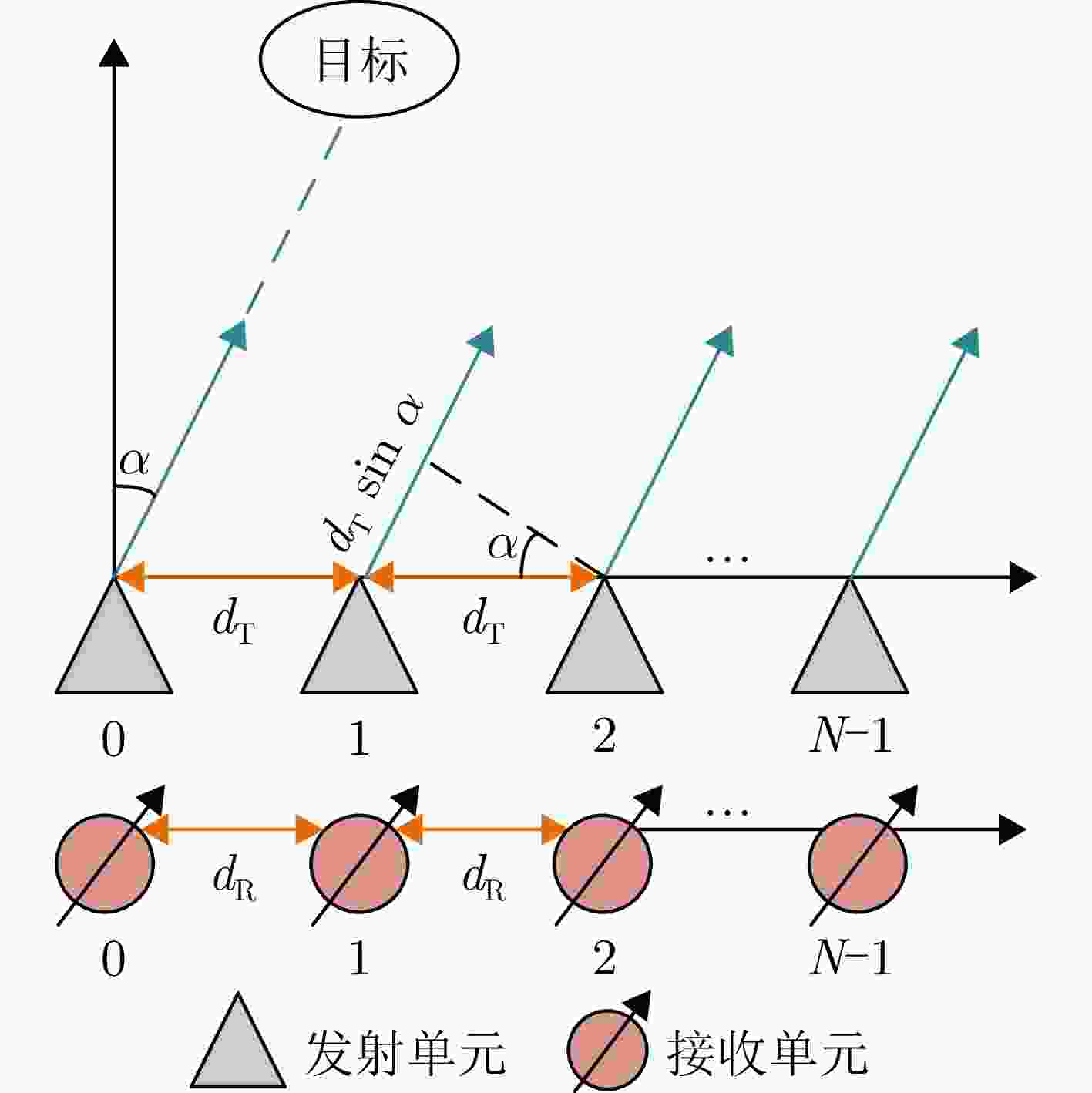
 下载:
下载:
